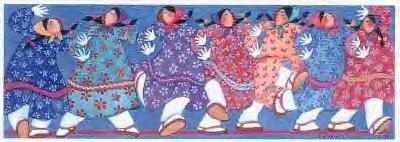|
|
An Inuit Showcase
by Rachel Attituq Qitsualik from Nunatsiaq News
|
For a few brief months, the Arctic is as alive as a jungle, which it once was an unfathomable number of years ago. And as their most distant ancestors before them also did, Inuit groups come together in this time, to celebrate life and prosperity in a way that is all their own. It is the time for Qaggiq — the summer celebrations. Like its winter counterpart (coinciding roughly with winter equinox), the summer festival is not so much a forum for competition, as it is an exercise in generosity, a vehicle of expression for both the body and the soul. The games may vary, but the message is perennial: to enjoy one's efforts, and to encourage others in their own. Opponents in the games applaud each other, regardless of which contestant "won." Mutual animosity between the contestants is alien to these games. Ego rarely has a place in the events, and the ability to laugh at one's self is as integral to the festival as the activities themselves. Even though many of the events are as athletic as anything seen in the Olympics, the "game" aspect of the events is emphasized far more than that of the "sport." Events include the harpoon toss, rope gymnastics, running races, canoe races, the "good woman" contest, mouth-pull, musk-ox, seal hop, aeroplane, Alaskan high kick — just to name a few. Some are modern variations on old traditions; for example, in the "good woman" contest, one races others to make bannock in the least amount of time. There are a dizzying array of dances from all regions. The air resonates with singing and throat chanting. Everyone has a turn at drumming and the blanket toss. While many events are technically gender-specific, the atmosphere is so relaxed that genders often intermingle. I remember when I once saw an old man fillet a fish for drying better than any traditional woman. There are formidable two-legged high jumpers of either gender. And what if you mess up your routine? Well, try again. Your opponent is likely to coach you, saying, "Here, try it this way. This works better for me." Oh, and the food...
In this way, the festival is unique. The events not only represent the passing on of age-old skills, but a chance to grow and affirm one's identity in comparison to others. All, male or female, child or elder, participate equally and assert that all is well with culture and spirit. It is a way to maintain a wholesome society that reinforces excellence and at once encourages effort. Today, those events of yesteryear have found themselves transformed into the Northern Games. July of this year will mark the 25th Anniversary of the Northern Games, held in Inuvik. To those readers who are of this land's most ancient culture: whatever region you are from, you are as likely as I am to feel a belonging to these games. They are our own. As a song I once heard at a gathering went: "we are Inuit and we are still here." What better way to celebrate this fact than with each other, thus affirming our uniqueness? From Alaska, all across the West to the East, Baffin to Northern Quebec, we are Inuit and we are still here. To those readers of alternate descent: may this festival call to you as well. Come and enjoy it, and perhaps learn something of what has always been most dear to the Peoples of the Arctic. After all, is this not a time for Inuit? And as anyone can tell you, "Inuit" is simply an Inuktitut word for humanity. Pijariiqpunga.
Traditional Inuit Games Print and color your own pictures of the Inuit life Cool Colouring |
|
|
| Canku Ota is a free Newsletter celebrating Native America, its traditions and accomplishments . We do not provide subscriber or visitor names to anyone. Some articles presented in Canku Ota may contain copyright material. We have received appropriate permissions for republishing any articles. Material appearing here is distributed without profit or monetary gain to those who have expressed an interest. This is in accordance with Title 17 U.S.C. section 107. |
|
Canku Ota is a copyright of Vicki Lockard and Paul Barry. |
|
 Following
a severe winter, the spring thaw follows with a vengeance that is awesome to behold. Plants explode into growth,
tracking the midnight sun. Birds flock as far as the eye can see, hailing from lands as distant as Argentina. The
large mammals — caribou, musk-ox, narwhal, beluga and bowhead whales — undertake eternal and herculean journeys
to their respective calving grounds.
Following
a severe winter, the spring thaw follows with a vengeance that is awesome to behold. Plants explode into growth,
tracking the midnight sun. Birds flock as far as the eye can see, hailing from lands as distant as Argentina. The
large mammals — caribou, musk-ox, narwhal, beluga and bowhead whales — undertake eternal and herculean journeys
to their respective calving grounds. In
order to understand the spirit of the games, you have to understand the roots of Inuit cultural survival. For specialized
skills to be passed on from generation to generation in an unforgiving land, you had to have a mechanism not only
by which to improve your own skills, but to grow into a healthier person through competition — a way to learn how
to be an excellent human.
In
order to understand the spirit of the games, you have to understand the roots of Inuit cultural survival. For specialized
skills to be passed on from generation to generation in an unforgiving land, you had to have a mechanism not only
by which to improve your own skills, but to grow into a healthier person through competition — a way to learn how
to be an excellent human.